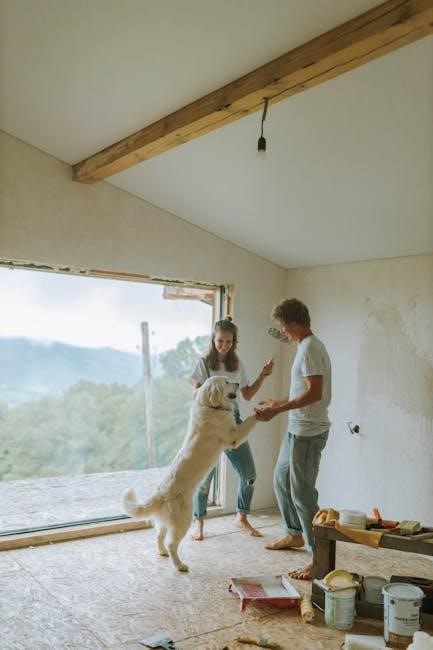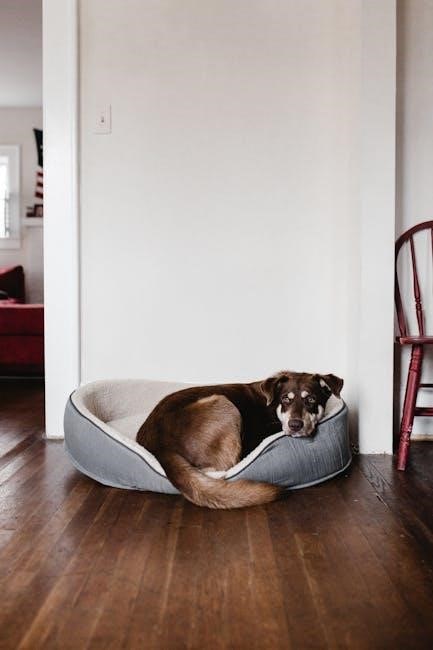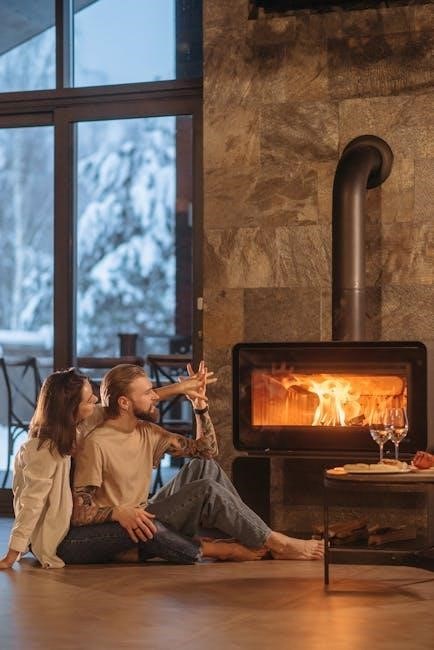dog house plans pdf
Welcome to our guide on dog house plans PDF! Discover comprehensive designs, detailed instructions, and customizable options for a perfect DIY project tailored to your dog’s needs.
1.1 Overview of Dog House Plans
Dog house plans PDFs offer a wide range of designs, from simple shelters to elaborate structures. These plans cater to various dog breeds, sizes, and weather conditions, ensuring comfort and safety. Many include customizable features, such as adjustable dimensions and material options, allowing owners to tailor the house to their pet’s needs. Detailed blueprints, cutting lists, and step-by-step instructions make DIY construction accessible. Whether you prefer modern, rustic, or A-frame styles, PDF plans provide a clear guide for building a durable and cozy home for your dog.
1.2 Importance of Using PDF Plans
Using PDF plans for dog houses ensures clarity and precision in construction. These files are easily accessible and printable, providing detailed measurements and step-by-step instructions. PDFs are ideal for DIY projects, as they offer portability and readability on various devices. They often include visuals and diagrams, making it easier to follow along. Whether you’re a novice or experienced builder, PDF plans streamline the process, saving time and reducing errors. This format is versatile and user-friendly, making it a practical choice for building a dog house.
Factors to Consider Before Building a Dog House
Before building, assess your space, budget, and the dog’s needs to ensure the house is functional, safe, and tailored to its preferences and environment.
2.1 Climate and Weather Conditions
Consider the local climate to ensure the dog house provides adequate protection. In colder regions, insulation is crucial, while in hot areas, ventilation and shade are priorities. Rainy climates require a waterproof roof, and snowy conditions may need a sloped design. Windy areas might necessitate anchoring the house. Choose materials durable enough to withstand extreme weather conditions, ensuring your dog’s comfort and safety year-round. Proper planning helps create a shelter that adapts to various environmental challenges effectively.

2.2 Dog Breed and Size Requirements
When designing a dog house, consider your dog’s breed and size to ensure comfort. Larger breeds need more spacious interiors, while smaller breeds require adequate insulation. Measure your dog to determine the ideal floor space and height. The entrance should be proportional to your dog’s size for easy access. Adjustable designs can accommodate growing puppies. Tailor the house to fit your dog’s specific needs, ensuring it provides a comfortable and safe retreat. Proper sizing ensures your dog feels secure and happy in its new home.
2.3 Insulation and Ventilation Needs

Insulation and ventilation are critical for maintaining a comfortable temperature inside the dog house. Proper insulation, such as foam or straw, helps regulate heat in both cold and warm climates. Adequate ventilation prevents moisture buildup and reduces odors. Install vents or windows to ensure airflow while keeping the interior dry. These features are essential for your dog’s health and comfort, ensuring the house remains safe and cozy year-round.

Popular Styles of Dog Houses
Popular dog house styles include modern, rustic, and A-frame designs. Each style offers unique features, ensuring durability, comfort, and aesthetic appeal for your pet.
3.1 Modern Dog House Designs
Modern dog house designs emphasize clean lines, minimalist aesthetics, and functional simplicity. They often feature sloped roofs for water runoff, large entrances for easy access, and sleek, contemporary materials like metal or recycled wood. These designs cater to urban and suburban settings, blending seamlessly with modern architecture. Many include innovative features such as sliding doors, adjustable ventilation, and eco-friendly insulation, ensuring comfort and durability. Modern styles are versatile, accommodating various dog breeds and yard sizes while maintaining a sophisticated look.
3.2 Rustic and Traditional Designs
Rustic and traditional dog house designs offer a charming, timeless appeal, often resembling miniature cottages. These plans typically feature gabled roofs, wooden accents, and decorative trims, blending seamlessly with rural or country settings. They emphasize durability and simplicity, using natural materials like cedar or pine. Porches, shutters, and other classic details add character, making these designs perfect for pet owners who prefer a cozy, welcoming atmosphere for their dogs. They are both functional and aesthetically pleasing, ensuring long-lasting comfort.
3.3 A-Frame and Sloped Roof Styles
A-Frame and sloped roof dog houses are popular for their durability and water runoff efficiency. These designs feature angled roofs that shed snow and rain effectively, making them ideal for colder climates. Sloped roofs also provide excellent ventilation and can be customized with various materials. A-Frame styles are easy to construct and offer a cozy, compact space for dogs. Their simplicity and functionality make them a practical choice for pet owners seeking a sturdy, weather-resistant shelter.
Materials and Tools Required
Building a dog house requires materials like wood, nails, screws, and roofing. Essential tools include a saw, drill, hammer, and measuring tape.
4.1 Wood Selection and Safety
Selecting the right wood is crucial for durability and safety. Opt for weather-resistant woods like cedar or pine. Ensure wood is free from knots and splinters. Avoid treated wood to prevent chemical exposure. Sand all surfaces for a smooth finish. Always pre-drill holes to prevent splitting. Use non-toxic wood finishes to ensure your dog’s safety. Proper wood selection and preparation ensure a sturdy and safe dog house.
4.2 Essential Tools for Construction
Building a dog house requires essential tools for precise and safe construction. A circular saw or hand saw is necessary for cutting wood. A drill is needed for screwing pieces together. Measuring tape ensures accurate cuts and assembly. A hammer is useful for tapping pieces into place. Sandpaper smooths rough edges, and a level ensures the structure is even. Basic hand tools like screwdrivers and wrenches are also essential. Having these tools ready guarantees a smooth and efficient building process.

Safety Considerations
Ensure the dog house is structurally sound and free from hazards. Use non-toxic materials to protect your dog from harm. Always follow safety guidelines during construction.
5.1 Avoiding Toxic Materials
When building a dog house, it’s crucial to avoid materials that may harm your pet. Steer clear of treated wood, which contains chemicals like arsenic, and opt for untreated, natural wood instead. Avoid paints or stains with high VOCs or toxic additives. Choose non-toxic adhesives and sealants to ensure your dog’s safety. Always verify the safety of materials by checking labels or manufacturer information. Using eco-friendly, pet-safe products ensures a healthy environment for your dog.
5.2 Secure and Sturdy Construction
A sturdy frame is essential for the structural integrity of the dog house. Use durable, weather-resistant materials to ensure longevity. Anchor the dog house to prevent movement from strong winds. Secure the roof properly to withstand harsh weather conditions. Weatherproof fasteners will prevent the structure from loosening over time. Ensuring a secure and sturdy construction guarantees your dog’s safety and comfort, providing a reliable shelter for years to come.
Detailed Plans and Blueprints
Detailed plans provide precise measurements and step-by-step instructions for building a dog house. They include 2D and 3D diagrams, catering to various skill levels and dog sizes.
6.1 Free vs. Paid PDF Plans
Free PDF plans offer basic designs for simple dog houses, ideal for DIY enthusiasts on a budget. Paid plans provide detailed, customizable blueprints with advanced features, ensuring durability and tailored designs. Free options are great for small projects, while paid versions suit complex builds requiring precision and uniqueness. Both cater to different needs, but paid plans often include expert tips and warranties for better results;
6.2 Customizable Features
High-quality PDF plans often include customizable features, allowing you to tailor the dog house to your pet’s needs. Adjustments can be made to size, material choices, and roof designs. Some plans offer options for door placement, window additions, or interior features like bedding supports. These customization options ensure the dog house is functional, comfortable, and visually appealing, making it a perfect fit for your dog and your yard’s aesthetic. This flexibility enhances both comfort and practicality.

Budgeting for Your Dog House
Budgeting involves estimating material costs, labor, and tools. Prioritize essential expenses and allocate funds wisely to ensure quality without overspending. Plan for future maintenance costs.
7.1 Material Costs and Estimates
Material costs vary based on the type and quality of supplies. Wood, metal, and plastic are common materials, with costs ranging from $50 to $200 for small dog houses. Larger designs or premium materials can increase expenses up to $500. Factors like climate may require additional insulation, affecting the budget. Always compare prices at hardware stores or online to find the best deals. Planning ahead helps avoid overspending and ensures the project stays within budget.
7.2 Saving Money on Supplies
Saving money on supplies requires smart shopping and planning. Consider using reclaimed wood or discounted materials from local stores. Buying in bulk for future projects can also reduce costs. Compare prices online to find the best deals. Look for seasonal sales or discounts on tools and materials. Additionally, opt for durable, cost-effective alternatives like plastic or metal for certain parts. Planning ahead ensures you purchase only what’s needed, avoiding unnecessary expenses.

Step-by-Step Construction Guide
Begin with site preparation, then assemble the frame, and install the roof and insulation. Use the provided plans and materials list for accuracy and a sturdy build.
8.1 Preparing the Site
Clear the area of rocks, debris, and vegetation. Level the ground to ensure stability. Check for proper drainage to prevent water pooling. Measure the space according to your PDF plan; Mark the corners with stakes. Lay down gravel or sand for a stable base. Ensure the site is dry and well-ventilated. This preparation ensures a solid foundation for your dog house, following the blueprint provided in your PDF guide.
8.2 Assembling the Frame
Begin by cutting the lumber according to the dimensions in your PDF plan. Use a circular saw for precise cuts. Assemble the frame using screws and a drill. Start with the base, then attach the sides and back. Ensure the corners are square and the structure is level. Follow the plan’s instructions for frame reinforcement. Sand any rough edges for safety. Secure the floor to the frame to create a sturdy base for the dog house.
8.3 Installing Roof and Insulation
Start by attaching the roof rafters to the frame, ensuring they are evenly spaced. Cover with plywood or oriented strand board (OSB) for the roof deck. Install asphalt shingles or roofing felt for weatherproofing. Add insulation to the walls and floor using foam board or fiberglass batting. Secure the insulation with adhesive or staples. Finish by installing a vapor barrier to prevent moisture buildup. Ensure the roof is securely fastened to withstand wind and weather conditions.

Maintenance and Upkeep
Regularly clean the dog house, inspect for damage, and repair as needed. Ensure proper ventilation and dryness to keep your dog safe and comfortable.
9.1 Cleaning the Dog House
Regular cleaning is essential to maintain a healthy environment for your dog. Remove dirt, debris, and old bedding. Disinfect surfaces with pet-safe products to prevent bacteria and odors. Check for pests like fleas or mites and treat if necessary. Wash bedding frequently and ensure the house remains dry to prevent mold. Regular cleaning also helps extend the lifespan of the dog house, keeping it comfortable and safe for your pet.
9.2 Regular Inspections
Regular inspections ensure the dog house remains safe and durable. Check for signs of wear, rot, or damage to wood and roof. Look for gaps or holes that may let in pests or water. Inspect insulation for effectiveness and ensure proper ventilation. Replace worn-out bedding and tighten loose screws or nails. Regular checks help prevent major repairs and keep the dog house in good condition, providing a comfortable shelter for your pet year-round.
Customization Ideas
Customize your dog house with vibrant paints, decorative trim, and personalized nameplates. Add solar panels or stylish roofing to enhance functionality and visual appeal.
10.1 Adding a Porch or Deck

Adding a porch or deck to your dog house enhances comfort and style. Use durable materials like wood or composite for a sturdy structure. Incorporate railings for safety and cushions for relaxation. Ensure the design matches your dog’s size and breed, providing shade and a cozy spot to unwind. This feature not only improves functionality but also boosts your dog’s overall enjoyment of their outdoor space.
10.2 Incorporating a Cooling System
Incorporating a cooling system into your dog house ensures comfort during hot weather. Consider adding mist sprinklers or ventilation windows to circulate air. Reflective materials like light-colored roofing can reduce heat absorption. For advanced setups, install a small, pet-safe cooling pad or evaporative cooling system. These features help regulate temperature, keeping your dog cool and relaxed, especially in warmer climates. Ensure the system is energy-efficient and tailored to your dog’s specific needs for optimal comfort.
Building a dog house with a PDF plan is a rewarding project that ensures your pet’s comfort and safety. With clear instructions and customizable designs, creating the perfect shelter is easier than ever. Start your project today and give your furry friend the home they deserve!
11.1 Final Tips for Success
- Always follow the PDF plans carefully to ensure accuracy and safety.
- Use durable, weather-resistant materials to protect your dog from elements.
- Double-check measurements and construction steps before finalizing.
- Consider adding a finish, like paint or sealant, for long-lasting protection.
- Ensure proper ventilation and insulation for your dog’s comfort.
- Inspect the dog house regularly to maintain its quality and safety.

Additional Resources
For further guidance, explore recommended websites offering detailed PDF plans, and watch tutorials for expert tips on constructing the perfect dog house.
12.1 Recommended Websites
Discover top websites offering free and premium dog house plans in PDF format. Platforms like Pinterest, Instructables, and The Spruce Crafts provide diverse designs and tutorials.
These sites feature detailed blueprints, material lists, and step-by-step guides. They cater to various skill levels, ensuring you find a plan that suits your needs.
Many offer customizable options, allowing you to tweak designs for your dog’s comfort and your yard’s style. Explore these resources for inspiration and practical guidance.
12.2 Helpful Videos and Tutorials
Enhance your dog house building project with video tutorials and guides. Platforms like YouTube, Pinterest, and Instructables offer step-by-step DIY videos.
These tutorials cover topics such as assembling frames, installing roofs, and adding insulation. Many videos showcase modern and rustic designs, providing inspiration and practical tips.
They often include time-saving techniques and safety advice, making them invaluable for both beginners and experienced builders. Use these resources to ensure your dog house is sturdy, comfortable, and perfectly tailored to your pet’s needs.
